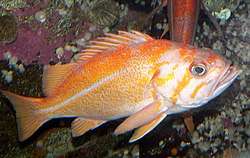Canary rockfish
The canary rockfish (Sebastes pinniger) is a rockfish of the northeast Pacific Ocean, found from south of Shelikof Strait in the eastern Gulf of Alaska to Punta Colonet in northern Baja California.
| Canary rockfish | |
|---|---|
 | |
| Sebastes pinniger at the Vancouver Aquarium | |
| Scientific classification | |
| Kingdom: | |
| Phylum: | |
| Class: | |
| Order: | |
| Family: | |
| Genus: | |
| Species: | S. pinniger |
| Binomial name | |
| Sebastes pinniger (T. N. Gill, 1864) | |
Species description
As the name suggests, this rockfish is notable for a general orange-yellow appearance, consisting of a blotchy orange pattern over a whitish or light gray background. The head has three stripes angling downwards and back, the middle one generally running across the eye, and the other two on each side of the eye. The lateral line is in a clear area. The fins are orange, with the pectoral, pelvic, and anal fins somewhat pointed and larger (thus the species epithet pinniger, meaning "I bear a large fin"). Some individuals have dark blotches on the body or dorsal fin. Maximum recorded length if 76 cm (29.6 in).
Ecology and conservation status
Young canaries live in relatively shallow water, moving to deeper water as they mature. Adults are mostly found at depths of 80–200 meters (with two recorded at 838 meters), tending to collect in groups around pinnacles and similar high-relief rock formations, especially where the current is strong. Some off Oregon have been reported living over flat rock and mud-boulder bottoms. They may move considerable distances; one individual covered 700 km in four years after being tagged and released. Juveniles feed on small crustacea such as krill larvae (and eggs), copepods and amphipods, while adults eat krill and small fishes.
They have been an important commercial species since at least the early 1880s, with fisheries off San Francisco, California and Washington state. They are caught in trawling and hook and line operations, along with a variety of other fish such as yellowtail, lingcod, and other rockfishes. The population on the U.S. West Coast were declared overfished in 2000 and a recovery plan was implemented in 2001. This stock was declared rebuilt in 2015.[1]
In 2007, the National Marine Fisheries Service (NMFS) received a petition to list a distinct population segment (DPS) of canary rockfish, and four other rockfishes, in Puget Sound, as an endangered or threatened species under the Endangered Species Act).[2] (ESA). NMFS found that this petition presented enough information to warrant conducting a status review of the species. Based on the status review NMFS proposed listing this species as threatened in 2009.[3] After a later review that included new genetic analyses,[4] a final listing decision was made in January 2017:
Based on recently obtained new genetic information that indicates that the Puget Sound/Georgia Basin population of canary rockfish is not genetically discrete from canary rockfish on the coast, we published a final rule in January 2017 removing the Puget Sound/Georgia Basin DPS of canary rockfish from the Federal List of Threatened and Endangered Species list. Because of the lack of discreteness in the Puget Sound/Georgia Basin canary rockfish population, we find that it does not meet the DPS criteria and therefore does not qualify for listing under the Endangered Species Act.[5]
References
- "Petrale Sole and Canary Rockfish, Important West Coast Groundfish Stocks, Rebuilt to Sustainable Level". Pacific Fishery Management Council.
- "Endangered Species Act".
- "Proposed listing status for Puget Sound rockfish" (PDF).
- National Marine Fisheries Service (2016), 5-Year Review: Summary and Evaluation. Yelloweye rockfish (Sebastes ruberrimus), canary rockfish (Sebastes pinniger), and bocaccio (Sebastes paucispinis) of the Puget Sound/Georgia Basin (PDF), Seattle, Washington: National Marine Fisheries Service, Office of Protected Resources
- "Canary Rockfish (Sebastes pinniger)". NOAA Fisheries, Office of Protected Resources.
- "Sebastes pinniger". Integrated Taxonomic Information System. Retrieved 11 March 2006.
| Wikimedia Commons has media related to Sebastes pinniger. |
- Milton S. Love, Mary Yoklavich, Lyman K. Thorsteinson, (2002), The Rockfishes of the Northeast Pacific, University of California Press, pp. 234–236
- Froese, Rainer and Pauly, Daniel, eds. (2006). "Sebastes pinniger" in FishBase. March 2006 version.
- National Marine Fisheries Service canary rockfish webpage